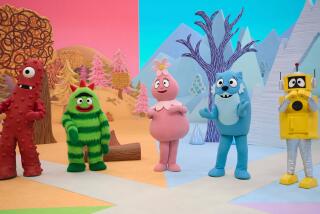‘Sesame Street’ at 40: The importance of being Ernie -- and Bert and Kermit . . .
Happy birthday, “Sesame Street.” You are 40 years old now, just a year younger than Mickey Mouse was the year you arrived on television -- and he was semi-retired by then, while you still report to work each day. This very morning you begin your 41st season, you and your cast of aging humans and ageless Muppets, with three first-episode veterans still in residence: Bob McGrath (who plays Bob), Loretta Long (called Susan) and Big Bird, who is still only 6 years old, although the man inside him, Caroll Spinney, will turn 76 next month. (The Bird’s voice has dropped a little, but you should be so spry.) That kind of continuity is rare, if not otherwise nonexistent, on television. Certainly there is no other children’s show to match you for longevity, cultural penetration or global reach.
The occasion is also being marked by the release of “Sesame Street: 40 Years of Sunny Days,” a two-DVD set that, given the fact that today’s episode is numbered 4,187, understandably fails to give the series its due. (Previously available sets spend three discs each on the first and second five years of the show.) But it does give something of its changing flavor and cast of characters (Kermit, Bert, Ernie, Cookie Monster, Grover, Elmo, Elmo, Elmo, Elmo), its working method and its huge ambitions: Birth, death, marriage, a hurricane -- the street has seen it all.
This was, of course, not the first educational series for kids. “Ding Dong School” with Miss Frances (Dr. Frances Horwich) goes back right to the Golden Age, and you could pick up odd bits of useful knowledge from “Captain Kangaroo,” still going strong when “Sesame Street” bowed in the year of the moon landing and Altamont, or from “Mister Rogers’ Neighborhood,” which premiered the year before. The franchised “Romper Room” suggested a pre-school, but in those days that meant marching in circles and ritual socialization: Do be a Do-Bee, Don’t be a Don’t-Bee; it didn’t get any deeper than that.
“Sesame Street,” by contrast, was conceived from the beginning as an instrument of learning and uplift -- a Head Start of the Air that would, by a sort of pedagogical jiujitsu, use the force of an addictive medium to its own higher ends. It was largely, though never exclusively, meant to give a leg-up to disadvantaged kids, and to get parents involved by putting on a show that was also attractive to them. I was no longer a child nor yet an adult when “Sesame Street” began, but I was certainly attracted: It looked like nothing else on television, showcasing independent animation at a time when that art was elsewhere reaching new lows. And it had Muppets, who came from the world of grown-up show business and added -- although it’s odd to say -- sophistication to the mix.
And then there was the setting: Where most kids’ shows took place within some snug refuge, a Treasure House or a Nice Man’s Living Room, “Sesame Street” is set in out on the sidewalk, and therefore in a community, in what was clearly the city of New York -- and not the Starbucked and Disneyfied Manhattan of contemporary commerce, but a funky working-class neighborhood where laundry dries on clotheslines and trash cans sit by the stoop. (They cast the brownstone steps in concrete so they would sound right when anyone pounded up or down them.) Radically -- really, radically, in 1969 -- it prominently featured black actors (and Latino and Asian soon afterward). The series remains peerlessly multicultural and multicolored -- blue, orange, red, green, yellow, purple, all the primary and secondary hues, plus the usual variations on black, white and brown.
Because it is in part publicly funded, and because, notwithstanding some fluctuation in viewership, it is regarded as important, it stirs up controversy now and again. That the next couple of seasons will feature a curriculum “designed to create a love and understanding of the natural world” some might describe as propaganda. And there was a small storm recently over a joke mentioning “Pox News” as a “trashy news show” -- that these were garbage-loving Grouches talking gives it the proper context, but PBS Ombudsman Michael Getler still blogged a kind of apology: “Broadcasters can tell parents whatever they think of Fox or any other network, but you shouldn’t do it through the kids.”
At the same time, the show also relies for survival on its success as a brand, a commercial entity: The wearing ubiquity of Elmo seems a function of that. New this year is a cartoon series, “Abby’s Flying Fairy School,” featuring sparkly pink Abby Caddaby, which is being ballyhooed as the first CGI transformation of a “Sesame Street” character, as if that were a great thing and not, as it seems to me, a bid to compete with other kids’ shows -- of which there are now many more than there were 40 years ago -- on their own, lower level. There’s more magic in even a moderately well-handled sock puppet than in the most expensively rendered computer image.
Still, every neighborhood changes with time. Cookie Monster also eats fruit now. The teaching of letters and numbers has contracted into a couple of spots in the show -- “40” is today’s number -- and the old mosaic approach, an energetically ragtag olio of short films interlaced with a longer street-set story, has been streamlined into a relatively few discrete blocks.
Like New York itself, it is a tidier place than in 1969. Still, “Sesame Street” is not here to satisfy my aesthetic preferences or Grouch-like nostalgia for the mud. It is here for your children, and for all the right reasons.
--
--
‘Sesame Street’
Where: KCET
When: 7 a.m. weekdays
Rating: TV-Y (suitable for young children)
More to Read
The complete guide to home viewing
Get Screen Gab for everything about the TV shows and streaming movies everyone’s talking about.
You may occasionally receive promotional content from the Los Angeles Times.







